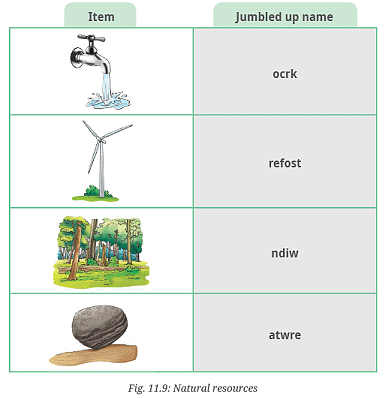Nature's Treasures NCERT Solutions | Science Class 6 PDF Download
Let us enhance our learning
Q1: Fig. 11.9 shows items related to natural resources. Match them with their jumbled up names. Make another table and write the names of these resources. Classify these resources as renewable or non-renewable. Ans: Jumbled up names:
Ans: Jumbled up names:ocrk = Rock
refost = Forest
ndiw = Wind
atwre = Water
Resources:

Q2: State whether the following statements are True [T] or False [F]. If False, correct them.
(i) Nature has all the resources to meet human needs. [T ]
(ii) Machines are a resource found in nature. [F]
Correction: Machines are human-made resources, not found in nature.
(iii) Natural gas is a non-renewable resource. [T]
(iv) Air is a renewable resource. [T]
Q3: Fill in the blanks using the most appropriate option—
(i) A fuel that is commonly used in two wheelers like scooters or bikes is _______
(a) Kerosene
(b) Petrol
(c) Diesel
(d) LPG
Ans: (b) Petrol
(ii) An example of a renewable resource is _______
(a) Coal
(b) Water
(c) Natural gas
(d) Petrol
Ans: (b) Water
Q4: Classify the following as renewable or non-renewable resources—coal, natural gas, forests and minerals.
Ans:
- Coal: Non-renewable
- Natural gas: Non-renewable
- Forests: Renewable
- Minerals: Non-renewable
Q5: Why do we say that petroleum is a non-renewable resource?
Ans: Petroleum is a non-renewable resource because it takes millions of years to form from the remains of microorganisms and plants buried deep inside the earth. Once used, it cannot be replenished within a human lifetime.
Q6: It is difficult to regrow forests. Justify this statement.
Ans: It is difficult to regrow forests because the process of growing trees to maturity takes many years. Additionally, the ecological balance and biodiversity that develop in a forest over centuries cannot be easily replicated. Human activities, such as large-scale deforestation, further complicate the regrowth of forests.
Q7: Make a list of five daily activities in which you use natural resources. Suggest ways by which you can reduce their use.
Ans: 
Q8: List four activities that are possible due to the presence of air.
Ans:
- Breathing
- Flying kites
- Inflating balloons
- Generating wind energy through windmills
Q9: How can you contribute towards enhancing the green cover of your locality? Make a list of actions to be taken.
Ans:
Actions:
- Planting trees and shrubs in the community.
- Encouraging community participation in tree-planting drives.
- Protecting existing trees from being cut down.
- Creating awareness about the importance of green cover.
- Supporting local initiatives that aim to increase green spaces.
Q10: In the given illustration, we see that food is being cooked. Answer the following questions: (i) What type of energy is being used for cooking?
(i) What type of energy is being used for cooking?
(ii) Name one benefit and one drawback of using this type of energy for cooking.
Ans:
(i) Solar Energy
(ii) Benefit: Solar energy is a renewable and clean source of energy. Hence it is environment friendly.
Drawback: Dependence on Weather: Solar energy cannot be used during cloudy days or at night, which limits its reliability and convenience.
Q11: Cutting down trees on a large scale impacts the quality of the soil. Why do you think it is so?
Ans: Cutting down trees on a large scale impacts the quality of the soil because tree roots help in binding the soil, preventing erosion. Without trees, soil becomes loose and can be easily washed away by rain or blown away by wind, leading to loss of fertile topsoil.
Q12: Explain two ways in which human activities pollute the air. Propose one action which can help in reducing air pollution.
Ans:
Ways of pollution:
- Emission of pollutants from vehicles.
- Industrial emissions releasing harmful gases.
Action to reduce pollution: Promote the use of electric vehicles and public transportation to reduce emissions from vehicles.
Q13: A family uses solar panels to generate electricity, a gas stove to cook food and a windmill for pumping water from a well. What would happen if there were no sunlight for a week?
Ans: If there were no sunlight for a week, the family would face issues with generating electricity through solar panels, which would affect their power supply. They might need to rely on alternative sources of energy for electricity.
Q14: Fill up the blanks using the following terms— (fossil fuels, forest, air, petroleum, coal, water and nonrenewable resource) Ans:
Ans:
(i) A fuel that is commonly used in two-wheelers like scooters or bikes is petroleum.
(ii) An example of a renewable resource is water.
(iii) Natural gas is a non-renewable resource.
(iv) Air is a renewable resource.
Q15: There is an increasing demand of trees to meet the requirements of industries and for housing. Therefore, trees are being felled. Is it justified? Discuss and prepare a brief report.
Ans: Report: The increasing demand for trees to meet industrial and housing needs is leading to deforestation, which is not justified. Trees are vital for maintaining ecological balance, providing oxygen, and supporting biodiversity. The felling of trees disrupts habitats, contributes to climate change, and leads to soil erosion. Sustainable practices, such as responsible logging, reforestation, and the use of alternative materials, should be adopted to balance development needs with environmental conservation.
Q16: Propose a plan to use less water in your school. What steps would you take to make this plan happen and how would it help the environment?
Ans:
Plan to Use Less Water:
- Use grey water for gardening purposes.
- Implement a rainwater harvesting system.
- Install water-efficient faucets and toilets.
Steps to Implement the Plan:
- Monitor water usage regularly and set reduction targets.
- Encourage student-led initiatives for water conservation.
- Collaborate with local authorities and experts to install water saving devices.
Environmental Benefits:
- Promotes sustainability and responsible water usage within the community.
- Decreases the energy used in water treatment and distribution.
|
99 videos|261 docs|49 tests
|
FAQs on Nature's Treasures NCERT Solutions - Science Class 6
| 1. What are the main types of natural resources discussed in "Nature's Treasures"? |  |
| 2. How do human activities impact natural resources? |  |
| 3. Why is conservation of natural resources important? |  |
| 4. What are some ways individuals can contribute to the conservation of nature? |  |
| 5. How does biodiversity relate to natural resources? |  |

|
Explore Courses for Class 6 exam
|

|

















